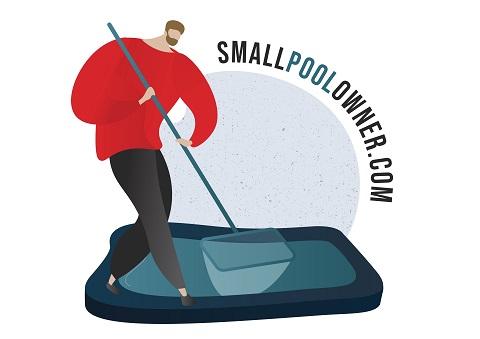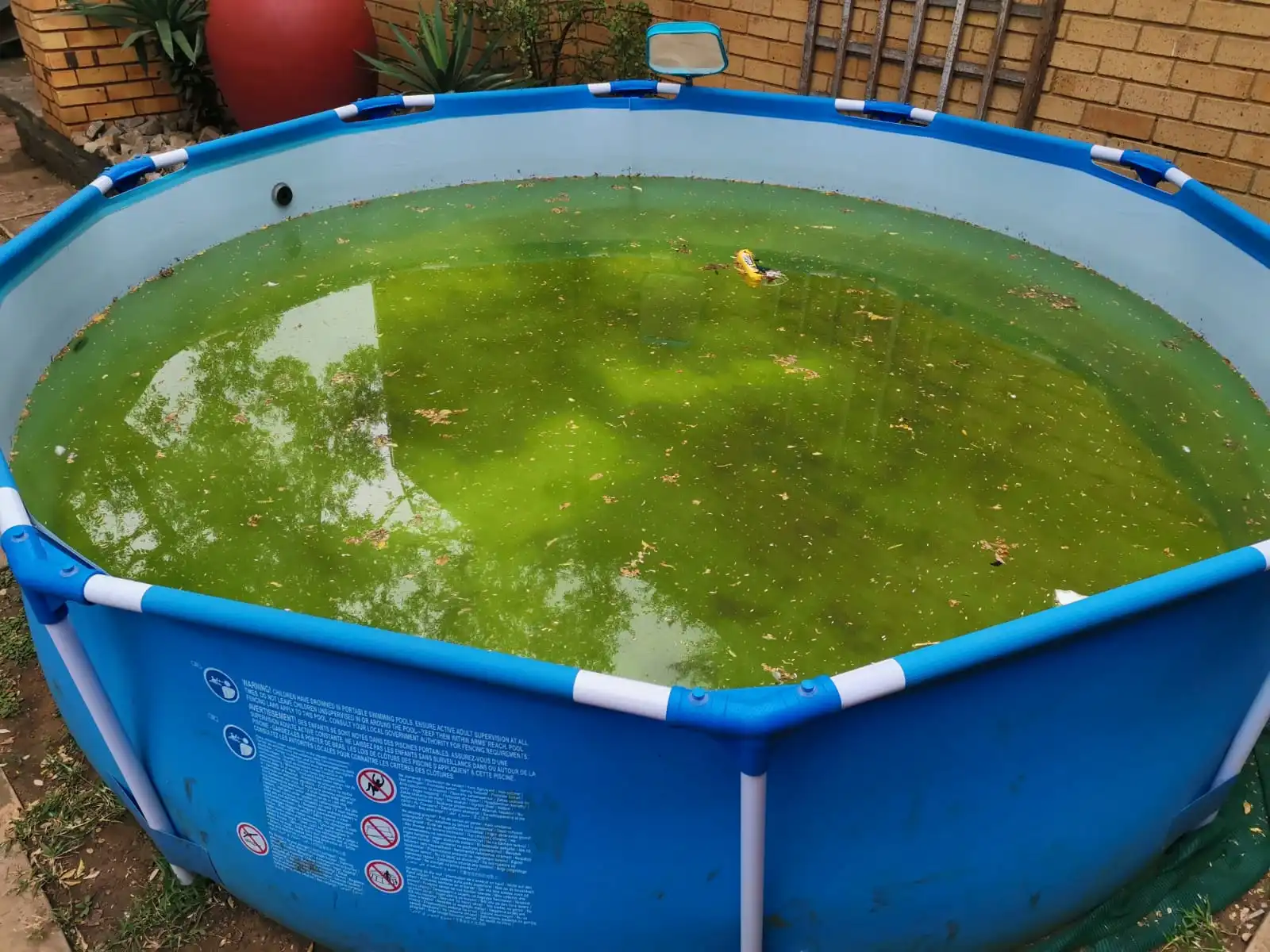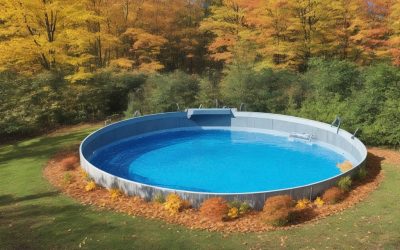Now, let’s be honest. No one. And we mean no one. Likes to swim or look at a green above ground pool (or any pool for that matter). It is just plain ugly. However, don’t worry it happens to most of us.
So we have established it is the proverbial sight for sore eyes. But a far bigger and better question would be, is a green above ground pool actually safe to swim in?
In general, you should avoid swimming in a green above ground pool. The main reason pool water turns green is due to a buildup of algae and bacteria, which can be harmful to swimmers either through skin infection or due to ingesting the bacteria. In severe cases, algae can cause serious illness or even death, although this is rare with suburban pools and water.
Swimming in green pool water may look unappealing, but it can also be risky to your health. The discoloration of the pool water is usually caused by algae or bacteria, which can cause skin rashes and other illnesses. Learn more here about the dangers associated with swimming in green pool water.
Is it Safe to Swim in a Green Above Ground Pool?
Swimming in green pools is safe in nature because the water contains an ecosystem complete with predators that keep bacteria and toxins at bay. Unfortunately, when pool maintenance falls behind algae becomes a superfood for more microbes than just humans. These microbes can enter through the nasal passages, eyes, ears, mouth, or even tiny cuts allowing it to become less safe to
Pollen from nearby plants can cause a green color in the pool, so it’s important to make sure there aren’t any allergies. If you have no issues with pollen then you should be able to swim in your pool without any problems.
Also, it is less of a risk with above-ground pools, but algae is slippery and can cause other types of injuries.
What causes an Above Ground Pool to Turn Green?
Many factors are responsible for turning your pool water from the clear blue state to a green shade. If the new green color is pale, it might be due to small algae formation in response to inadequate cleaning chemicals such as chlorine or bromine etc.. However, if the new color is deep green, that might mean a larger algal growth. Algae produces bacteria which can cause skin rashes and other illnesses if ingested, making swimming in green water hazardous.
Pollen from nearby plants can cause a green color in the pool, so it’s important to make sure there aren’t any allergies. If you have no issues with pollen then you should be able to swim in your pool without any problems.
That said; the absolute NUMBER ONE reason why your above ground pool turns green is;
Not swimming in it. The moment your pool water is stationary for whatever reason there will form a build up of algae and bacteria, turning your water green. So even in the winter months try to get some regular movement in your pool to prevent this.
If your pool water is green, it is important to first properly test the pH and chlorine levels to determine the cause of the discoloration. If the water’s pH level or chlorine levels are off, you should raise or lower them and re-test in a few days. You can also try adding shock powder or an algaecide to help remove algae growth if there is an excess. Ultimately, until the cause of the green pool water has been identified and treated, it’s best to avoid swimming in a green pool.
Health Hazards of Green Water
Swimming in green or dirty pool water can cause serious illnesses such as otitis externa (swimmer’s ear), conjunctivitis, and skin infections. Ingesting the water can also lead to stomach upset and diarrhea. Additionally, chlorine levels in green water are often too low to kill bacteria, making it more likely for people to get sick from swimming in it. It’s important to make sure your pool has the correct chemicals and is monitored regularly for safe swimming conditions.
Possible Contaminants Involved with Green Pool Water
Green pool water often contains bacteria and other dangerous contaminants, such as blue-green algae, that can cause numerous health problems. Other potential contaminants to be on the lookout for include nitrates, phosphates, lead, copper, and mercury. To ensure your pool is free of these hazardous elements and safe for swimming, it’s important to test your pool’s pH levels regularly.
If testing reveals that your pool’s levels are not adequate, it’s safest not to swim in the water until it can be treated and tested again. Contaminants like phosphates and nitrates cause algae to form in your pool. Nitrate buildup can contaminate drinking water aquifers, so it’s important to take steps to prevent them from building up in your swimming pool. It’s also important to use pool chemicals as directed, vacuum frequently, remove leaves before they sink to the bottom of the pool, and remove standing water from around the area of the swimming pool.
Precautions to Take When Swimming in a Above Ground Green Pool
Now, if you have to swim in a green above ground pool, then take a few steps to reduce your risk of illness. First, shower before and after swimming to remove any contaminants from the skin. Second, wear protective clothing when possible. Lastly, avoid ingesting any of the water while swimming or playing in it.
Pool owners should also inspect their pool regularly for any debris, other pollutants or foreign objects that can be pushed inside. The green water often occurs when algae has had a chance to grow in the pool, so check chlorine and pH levels before jumping in. If possible, chlorine shock the pool to get rid of the algae; make sure you wait at least 24 hours after shocking before swimming. Additionally, run the filter system for about 8 hours and clean out clogged filters on a regular basis to help prevent future issues with green water.
What to do if your Above Ground Pool turns Green?
If a pool has already developed an algae infestation, then it is necessary to do more than just pour some bleach into the pool. It’s time for a total clean.
Vacuum to Waste
To remove the algae and other debris, the filter setting needs to be set to “Waste”. Since it’s unsanitary for this junk to get back into pool water, always clean the vacuum filter after use.
Brush the Pool
Special algae brushes are available. Though it’s stronger, you should use a stiffer brush instead of a soft one so that the entire layer gets removed.
Yes, brush the pool floor after you vacuum or clean it to ensure that algae remain in the water.
Test Chemistry
To know which way to adjust the chemicals, get a starting point.
This can be done as the first step if that is easier for you.
Shock the Pool
Pool Shock contains concentrated chlorine and must be used to kill algae. Regardless of the type of shock originally present, chlorine should be used instead.
PS: we provide some awesome tips in this article as to prevent to how to prevent your above ground pool to turn gree
To recap….
We asked the question if it is safe to swim in a green above ground pool. As mentioned is not necessarily unsafe, however, since there is a threat of illness and infection, it is better to avoid swimming in one.
The main reason why an above ground pool (or any pool) would turn green is due to the water not moving and can be treated with chemicals.
Related Question
Can you get sick from swimming in a pool with green algae?
Yes, swimming in a pool with green algae can cause health issues. Green algae in a pool can indicate that the water is contaminated with bacteria and other harmful microorganisms, which can cause illnesses such as ear infections, skin rashes, and gastrointestinal problems. Inhaling or ingesting the contaminated water can also lead to respiratory infections, particularly in individuals with weakened immune systems. Additionally, green algae can make the pool surface slippery and increase the risk of accidents and injuries. It’s essential to maintain proper pool sanitation and promptly address any signs of algae growth to prevent health issues and ensure a safe swimming environment.
Can you get an infection from a green pool?
You can undoubtedly get an infection if you swim in a green pool. A green pool is an obvious indication that pathogenic bacteria, viruses, and other microbes are present and ready to cause gastrointestinal issues, skin rashes, and ear infections. Additionally, if you have a weakened immune system, breathing in or ingesting contaminated water can make you more susceptible to respiratory infections and other health problems. A green pool’s slippery surface can also be a formula for slips, falls, and other mishaps. To keep your pool safe for swimming, it’s essential to prevent the formation of algae and other harmful bacteria and to ensure that you periodically clean and sanitize it.
Can you put too much chlorine in a green pool?
A green pool might turn out to be really nasty, and even dangerous, if you add too much chlorine. While chlorine is necessary to maintain pool water sanitary and free of dangerous bacteria, applying too much can lead to chemical burns, skin and eye irritation, and respiratory problems. Furthermore, adding too much chlorine may not always solve the issue and may potentially make it worse. It’s best to take the proper action when dealing with a green pool in order to establish a safe and healthy swimming environment. This entails cleaning up any debris, adjusting the water’s chemistry, and gradually introducing the right dose of chlorine. Additionally, when using pool chemicals, make sure to always abide by the manufacturer’s specifications and refrain from adding too much.







0 Comments